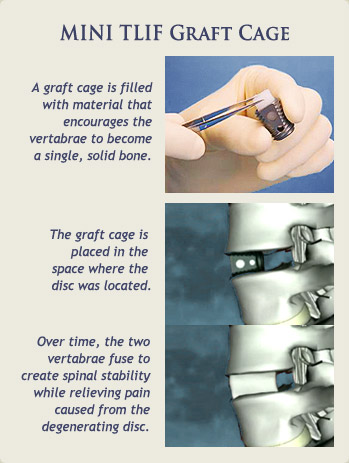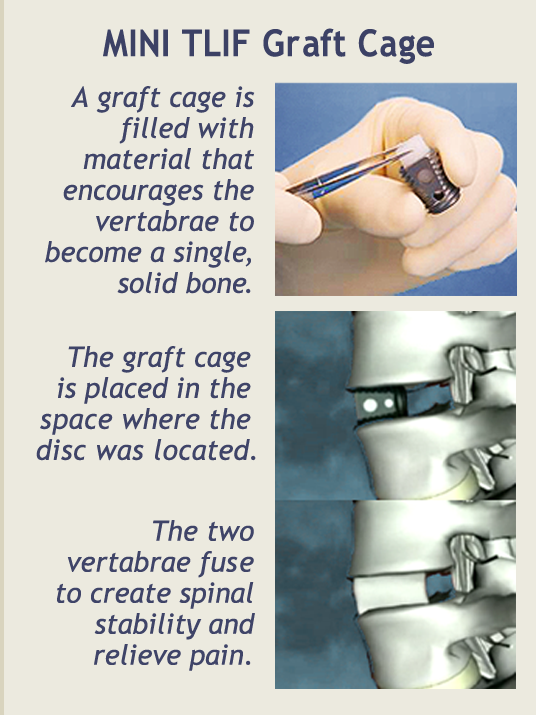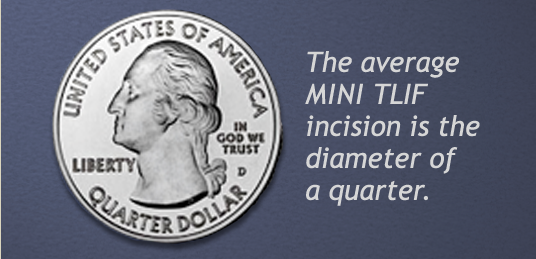
What is a MINI™ Transforaminal Lumbar Interbody Fusion?
The MINI (MicroInvasive Neuro Integration) Transforaminal Lumbar Interbody Fusion (TLIF) is one of four procedures that synthesize proven medical treatments and microsurgical instrumentation with the diagnostic methodology and experience of the neurosurgeons at Dallas Neurosurgical and Spine (DNS).
What conditions does the MINI TLIF treat?
The MINI TLIF procedure is most commonly performed to correct advanced degenerative disc disease – disc herniation, spinal column instability, certain types of spinal deformity or scoliosis, fractures and tumors.
What makes the MINI TLIF procedure unique?
Spine surgery to correct advanced degenerative disc disease involves a certain  degree of trauma to the back muscles, joints, discs and bony structures in order to decompress the nerves and stabilize the spinal column. The spine can be approached from a variety of directions including from the front (anteriorly), side (laterally), and back (posteriorly) can singly, or in combination, allow the surgeon complete access to the spine for decompression and fusion purposes.
degree of trauma to the back muscles, joints, discs and bony structures in order to decompress the nerves and stabilize the spinal column. The spine can be approached from a variety of directions including from the front (anteriorly), side (laterally), and back (posteriorly) can singly, or in combination, allow the surgeon complete access to the spine for decompression and fusion purposes.
The TLIF is differentiated from the more traditional posterior fusion approaches by a unilateral approach to the disc space through the intervertebral foramen - the natural opening made by two adjacent vertebrae through which the nerve root exits after branching off the spinal cord.
With the MINI TLIF, one or two incisions about 2 cm to 3 cm in length are made approximately 3 cm lateral to the midline. A tubular retractor is placed through the paraspinous musculature 
The average MINI TLIF incision is the diameter of a quarter.(muscles that run next to and roughly parallel to the spine). The muscles are separated, never cut, resulting in far less trauma. The retractor is set on the facet joint and a facetectomy (joint removal) with a partial laminectomy (removal of the spinal bony covering) is performed. Because the MINI TLIF provides excellent access to the posterior elements through the intervertebral foramen, less dural and nerve retraction is needed and contralateral scar formation is eliminated.
The disc space is cleaned out and a device called a TLIF graft cage is put into place and packed with fusion material to enhance fusion of the vertebral bodies above and below the cage implant. This material can include a patient’s own bone, stem cells, and/or bone matrix protein.
What about an alternative treatment like the PLIF?
The Posterior Lumbar Interbody Fusion (PLIF) can be an effective alternative treatment to the MINI TLIF. But for some patients, the MINI TLIF may offer several advantages. Because every patient and situation is unique, the best course of action is to discuss the range of options with a DNS neurosurgeon after a thorough diagnosis.
How do I know if I’m a good candidate for the MINI TLIF?
Surgery is usually recommended when all reasonable conservative measures (such as pain medication, injections, physical therapy, braces, etc.) have proven ineffective. However, in cases of significant instability or neurological problems, surgery may be the most appropriate first treatment option.
If your spine-related pain continues to adversely affect your quality of life and you can no longer be effectively treated for pain, numbness or weakness, we would encourage you to set up an appointment for an evaluation.
What results can I realistically expect after surgery?
Outcomes studies suggest the MINI TLIF procedure has a 90% to 94% long-term success rate. The procedure typically gives the patient the ability to get out of bed and back to enjoying a productive life in a matter of days.
As a general rule, the symptoms that most reliably improve after surgery are leg pain and weakness. Improvement in strength occurs gradually over several weeks, and in some patients, may not fully return. We can provide you a more accurate indication of success in your specific case after a consultation.
Some 31 million Americans experience low-back pain at any given time. And 65 million suffer within any given year.
Back pain is the second most common neurological ailment in the United States — only headache is more common. Acute back pain usually gets better without any treatment and generally lasts from a few days to a few weeks. Symptoms may range from muscle ache to shooting or stabbing pain, limited flexibility and range of motion or an inability to stand straight. Chronic back pain is pain that persists for more than 3 months. Prompt and proper diagnosis is the first essential step to recovery.




